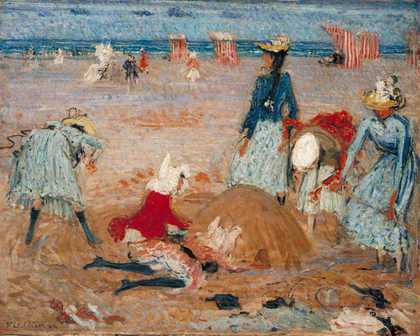
Philip Wilson Steer
Boulogne Sands (1888–91)
Tate
Philip Wilson Steer was beyond doubt the greatest of our landscape painters since Turner and Constable, inheriting the ethereal glow of the one vying with the other in his pursuit of the windy, silvery, delicious and blending French Impressionist strains with these in a new creation.
His summer work of near forty years, till his eyesight failed in 1935, was spent on ancient castle heights, river stretches and ports of England, with one notable excursion to Montreuil in 1907. His winter work was given to figure-pieces in the studio, and these he invested with something of landscape magic, a shimmering fabric of sun and air.
His occasional portraits are bold or subtle, but he could afford to evade any regular practice in that line.
His technique in oils varied from rough palette-knife impasto to the tenderest caressing with a sable. He developed, for rapid notes from nature, a method of watercolour, Chinese in its exact control of a fully charged brush, so that the wet flatness of a sea ran out to the horizon and lipped to the beach in one swift wash, or the umbrage of trees and play of clouds above their shadows were struck with simplified decisive tones once for all between damp and dry.
Save for hours given to teaching at the Slade School, the picking up of coins or other curios in a daily saunter, a game of chess or talk with friends of an evening, Steer’s life as a painter was undistracted. He read little and detested writing. He was a keen observer and penetrating critic but his sympathy with the efforts of others in the different job of painting was surpassed only by modesty about his own.
D.S. MacColl

